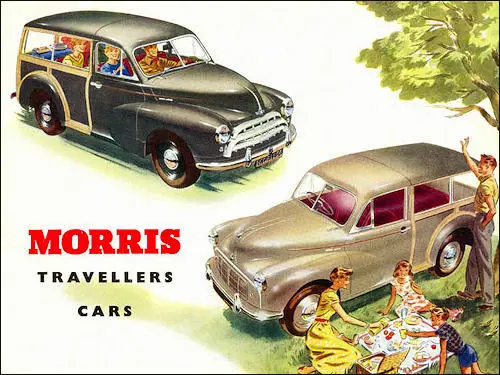THE MORRIS MINOR TRAVELLER AT SEVENTY
02 October 2023
Autocar of 9th October 1953 profiled a new version of a vehicle, one “considered by many people as a classic design of its type, and as such is often used as a yardstick when comparing small cars”. They further praised the “very bright and light interior” and the “particularly useful luggage compartment”. It was, of course, the Morris Minor “Travellers Car”.
The Traveller, as it became known, has been a fixture of the classic car world for so long it is easy to forget how unusual it was on its launch. There was no equivalent Ford rival, as the Escort/Squire 100E would not debut until 1955. Standard did not introduce the Ten Companion (unusually for its class, it boasted four side-doors) until 1955, while Vauxhall made no small cars post-war until the Viva in 1963.

That left the Rootes Group and Austin – the latter was also part of the recently formed British Motor Corporation empire. The Hillman Husky and the A30 Countryman appeared in 1954 but had a very different appeal to the Morris. As with the 100E, they were modified commercial vehicles, while the Traveller was a purpose-built estate that looked completely different from its ‘Morris Quarter Ton Van’ contemporary. It was indeed a Travellers Car, aimed at the sales representative who needed more luggage space and timber-framed respectability.
The Minor was not Morris’ first post-war estate, as that honour goes to the Oxford MO Traveller. Both retained the standard saloon body from the B-pillar forwards, with an ash-framed rear compartment. The wood shop at the Morris Bodies plant built the timber framework, with the final assembly at Cowley. The result was highly appealing, resembling a Tudor house on wheels from some angles.
And, whether you specified Birch Grey, Black, Clarendon Grey or Empire Green paintwork, your new Minor Travellers Car was bound to cause a stir in Acacia Avenue. The price of the basic version was £599 13s 4d, but your friendly local Morris dealer would tempt you into ordering the De Luxe for £622 6s 8d. After all, this additional sum was a small amount for enhanced respectability.
Morris promoted the Traveller as the sort of car a dashing chap in a cravat might drive to the golf course. The brochure further played on 1950s social insecurity, promising, “Whether you are making a social call, visiting the club, or spending the weekend with friends, the Travellers Car always looks ‘right’”.
The Minor was not the last timber-framed Morris, for in 1960, BMC unveiled the Mini Traveller with decorative woodwork instead of structural. Its later image as transport for middle-aged pipe smokers should not be allowed to undermine how dashing the timbered Minor appeared in 1953. As the sales copy promised: “Get more pleasure from your leisure with a Morris Travellers Car”.
